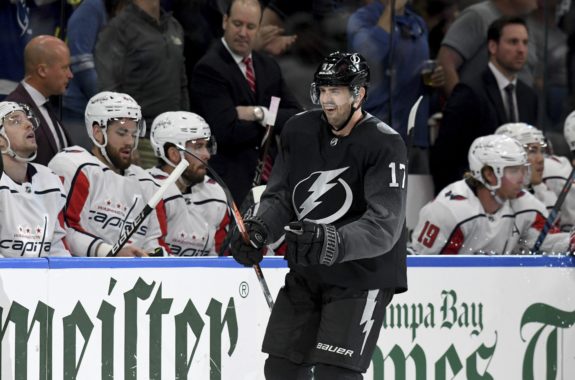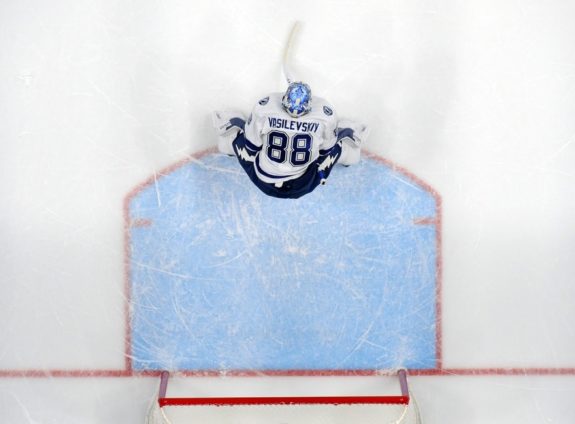Another week of Tampa Bay Lightning hockey is in the books, and another week has arrived with the club still outside of the playoff picture. They beat the Senators in overtime 4-3 on Tuesday, and despite playing one of their better games on Thursday, they lost to the Dallas Stars in overtime, 4-3. They also lost to the Washington Capitals Saturday night, 3-1.
At the beginning of the season, most of the hockey world assumed the Lightning would be back in the hunt for the Stanley Cup. Now, nearly to the halfway point of the season, the Lightning are three points back of a playoff spot in the Atlantic Division and seven points away from the second wild-card spot.
Related: Inconsistency Is Starting to Become Normal
In all three games this week, the Lightning showed flaws in every area of their game. There was a bit of silver lining, but all we can do now is break down what happened.
The Positive
Cirelli Driving the Bus
If Anthony Cirelli continues on his current pace, he will — in my opinion — finish in the top five, possibly the top three for the Selke Trophy. He only had one point this week, but it was the overtime goal that won the game against the Senators and showcased his abilities as a two-way forward.
Cirelli played anywhere from 18 to 21 minutes per game this week, including leading the Lightning in shorthanded ice time in all three games. He had seven shots over those three games, as well as four hits and four blocks. Joe Smith of The Athletic profiled Cirelli in which teammates Ryan McDonagh and Kevin Shattenkirk beamed about his abilities (From ‘How Anthony Cirelli became the Lightning’s ‘engine’ and why that complicates their summer cap crunch’, The Athletic — 12/18/19).
He might not score as often as the Nikita Kucherov’s or Steven Stamkos’ of the world, but Cirelli is a consistent presence on the ice and continued to prove that this week.
Penalty Kill Keeps Rolling
The Lightning penalty killers went 7-for-8 this week with the lone goal coming from the Stars on Thursday. Tampa’s top crew of Cirelli, Alex Killorn, Ryan McDonagh and Erik Cernak have kept their team in games where it could have gotten ugly after some bad penalties. And some credit should go to the goaltenders Andrei Vasilevskiy and Curtis McElhinney, who stopped 9-of-10 power-play opportunities.

Since early November, the penalty kill has been the most consistent aspect of the Lightning. They lead the league in penalty kill percentage since Nov. 1 at 87.5%, a vast improvement from their 72.5 penalty kill percentage from the start of the season to Nov. 1. The Lightning are 11th in the league with 139 penalties taken this season, and they’re fifth in penalty minutes per game at 10:01. With those kinds of stats, having the strong penalty killers the Lightning do is crucial. If they didn’t, who knows where they would be in the standings.
The Negative
No Improvements in Net
Last year, the Lightning goaltenders were spectacular. Andrei Vasilevskiy was the best goalie in the league, and backup Louis Domingue posted stellar numbers as the No. 2. This year, however, is a different story. Vasilevskiy has been below league averages for goaltenders and simply not looked sharp. Current backup Curtis McElhinney has not impressed so far, but the bottom line is this – if the Lightning want to make the playoffs and make a run for the Stanley Cup, both goaltenders — especially Vasilevskiy — must be better.

Vasilevskiy faced only 20 shots against the Stars, and the Bolts lost 4-3. Opposing goalie Anton Khudobin stole the game — something Vasilevskiy knows all too much about — and Vasy let in some very soft goals. It’s unfair to say he was the sole reason the Lightning lost that game, but his poor play certainly was a contributing factor.
Related: Lightning Should Give Vasilevskiy Some Time Off
In another article by The Athletic’s Joe Smith, Vasilevskiy said he is better when facing more shots, and his stats this season actually support the claim: “When facing 30 or more shots this season, Vasilevskiy is 8-4-1 with a .930 save percentage (32 goals on 461 shots). When seeing 25 shots or fewer, he’s 2-4 with an .822 save percentage (24 goals on 135 shots)” (From “Andrei Vasilevskiy opens up about struggles this season: ‘I’m a way, way, way average goalie’”, The Athletic — 12/21/19).
His reasoning made sense too, and while I don’t condone giving up a ton of chances, it might not be the worst thing in the world if it gets Vasilevskiy back on his A-game.
Let Down on the Power Play
The Lightning had just one power-play opportunity against the Senators and were 2-for-3 against the Stars.
Then came the Capitals. The Lightning couldn’t capitalize on two first-period power plays and one more in the second, and a pivotal moment in the game came when the Lightning failed on both chances of a 5-on-3 power play. The Capitals scored less than a minute after killing off the second penalty.

In all, the Lightning had seven power-play opportunities against Washington and couldn’t convert. Now, the Capitals do have the second-best penalty-killing unit in the league at 85.7 percent, but the Lightning have the second-best power play in the league at 28.1 percent.
While Capitals goaltender Braden Holtby made some great saves, the Lightning seemed to have trouble getting shots through and handling the puck. The fact of the matter is when your team has seven power-play chances in one night, you need to convert on at least one of them or it’s going to be really tough to win.
Looking ahead, the Christmas holiday might be a much-needed break for the Bolts. They have a home game against the Florida Panthers on Monday, then four days off for the holiday before hosting the Montreal Canadiens.
Those games, however, are more important than ever. The Canadiens are two points ahead of the Lightning, and the Panthers are three points ahead and third in the Atlantic Division. If they can win both of those games and carry that momentum into the New Year, the Lightning could cement their second or third-place finish in the division.